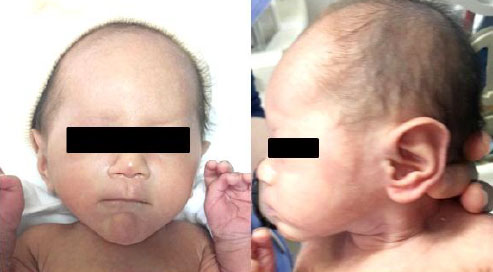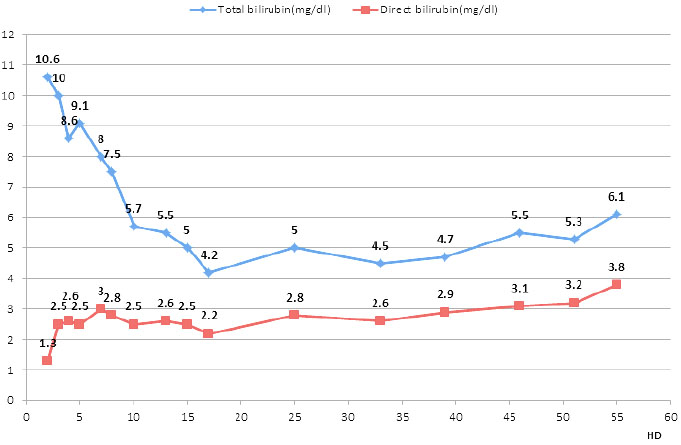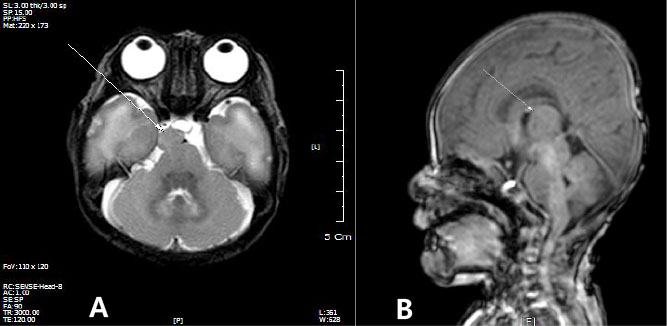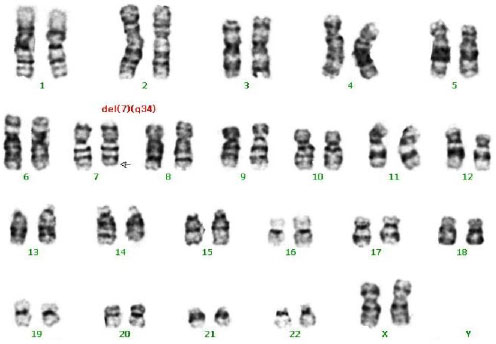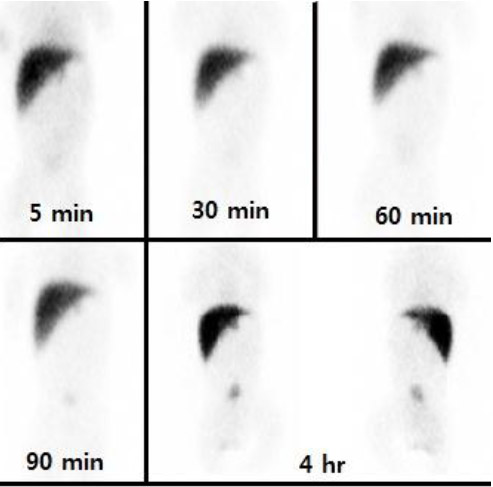Perinatology.
2016 Dec;27(4):255-259. 10.14734/PN.2016.27.4.255.
A Case of Chromosome 7q34 Deletion in an Infant with Hypothalamic Hamartoma and Biliary Atresia
- Affiliations
-
- 1Department of Pediatrics, Kyung Hee University School of Medicine, Seoul, Korea. baecw@khnmc.or.kr
- KMID: 2367038
- DOI: http://doi.org/10.14734/PN.2016.27.4.255
Abstract
- The chromosome 7q terminal deletion is a rare chromosomal disorder. It was first described in 1968 and has shown to have diverse clinical phenotypes. In this report, the phenotypes include growth retardation, bulbous nasal tip, microcephaly, abnormal ears, and hearing loss. In addition, we report on a new case of 7q34 deletion presenting with hypothalamic hamartoma and biliary atresia with a review of associated literatures.
MeSH Terms
Figure
Reference
-
1. De Grouchy J, Veslot J, Bonnette J, Roidot M. A case of?6p- chromosomal aberration. Am J Dis Child. 1968; 115:93–99.
Article2. Ayub S, Gadji M, Krabchi K, Côté S, Gekas J, Maranda B, et al. Three new cases of terminal deletion of the long arm of chromosome 7 and literature review to correlate genotype and phenotype manifestations. Am J Med Genet A. 2016; 170A:896–907.
Article3. Rush ET, Stevens JM, Sanger WG, Olney AH. Report of a patient with developmental delay, hearing loss, growth retardation, and cleft lip and palate and a deletion of 7q34-36.1: review of distal 7q deletions. Am J Med Genet A. 2013; 161A:1726–1732.
Article4. Rodríguez L, Cuadrado Pérez I, Herrera Montes J, Lorente Jareño ML, López Grondona F, Martínez-Frías ML. Terminal deletion of the chromosome 7(q36-qter) in an infant with sacral agenesis and anterior myelomeningocele. Am J Med Genet. 2002; 110:73–77.
Article5. Craig DW, Itty A, Panganiban C, Szelinger S, Kruer MC, Sekar A, et al. Identification of somatic chromosomal abnormalities in hypothalamic hamartoma tissue at the GLI3 locus. Am J Hum Genet. 2008; 82:366–374.6. Nizery L, Chardot C, Sissaoui S, Capito C, Henrion-Caude A, Debray D, et al. Biliary atresia: clinical advances and perspectives. Clin Res Hepatol Gastroenterol. 2016; 40:281–287.
Article7. Brandberg G, Raininko R, Eeg-Olofsson O. Hypothalamic hamartoma with gelastic seizures in Swedish children and adolescents. Eur J Paediatr Neurol. 2004; 8:35–44.
Article8. Kang S, Allen J, Graham JM Jr, Grebe T, Clericuzio C, Patronas N, et al. Linkage mapping and phenotypic analysis of autosomal dominant Pallister-Hall syndrome. J Med Genet. 1997; 34:441–446.
Article9. Kuo JS, Casey SO, Thompson L, Truwit CL. Pallister-Hall syndrome: clinical and MR features. AJNR Am J Neuroradiol. 1999; 20:1839–1841.10. Ng J, Paul A, Wright N, Hadzic N, Davenport M. Vitamin D levels in infants with biliary atresia: pre- and post-Kasai portoenterostomy. J Pediatr Gastroenterol Nutr. 2016; 62:746–750.11. Rurarz M, Czubkowski P, Chrzanowska K, Cielecka-Kuszyk J, Marczak A, Kamińska D, et al. Biliary atresia in children with aberrations involving chromosome 11q. J Pediatr Gastroenterol Nutr. 2014; 58:e26–e29.
Article12. Allotey J, Lacaille F, Lees MM, Strautnieks S, Thompson RJ, Davenport M. Congenital bile duct anomalies (biliary atresia) and chromosome 22 aneuploidy. J Pediatr Surg. 2008; 43:1736–1740.
Article13. Pak JH, Lee BG, Kim IK, Min JS, Choi CH. A case of 7q-syndrome. J Korean Pediatr Soc. 1992; 35:422–427.14. Yoon KN, Oh JH, Kim JH, Lee SJ, Koh DK. A case of 7q-syndrome. J Korean Soc Neonatol. 1998; 5:182–186.15. Sung NJ, Kim MJ, Kim YH, Jung JA, Yang S, Hwang IT, et al. Chromosome 7q deletion syndrome [46, XX, del(7)(q34)] with hydronephrosis. J Korean Soc Neonatol. 2005; 12:217–221.16. Roth JJ, Santi M, Pollock AN, Harding BN, Rorke-Adams LB, Tooke LS, et al. Chromosome band 7q34 deletions resulting in KIAA1549-BRAF and FAM131B-BRAF fusions in pediatric low-grade gliomas. Brain Pathol. 2015; 25:182–192.17. Cin H, Meyer C, Herr R, Janzarik WG, Lambert S, Jones DT, et al. Oncogenic FAM131B-BRAF fusion resulting from 7q34 deletion comprises an alternative mechanism of MAPK pathway activation in pilocytic astrocytoma. Acta Neuropathol. 2011; 121:763–774.
Article18. Jacob K, Albrecht S, Sollier C, Faury D, Sader E, Montpetit A, et al. Duplication of 7q34 is specific to juvenile pilocytic astrocytomas and a hallmark of cerebellar and optic pathway tumours. Br J Cancer. 2009; 101:722–733.
Article19. Mustapha M, Chardenoux S, Nieder A, Salem N, Weissenbach J, el-Zir E, et al. A sensorineural progressive autosomal recessive form of isolated deafness, DFNB13, maps to chromosome 7q34-q36. Eur J Hum Genet. 1998; 6:245–250.
Article20. Kodama Y, Narahara K, Yabuuchi H, Hirano A, Inoue H, Kimura S, et al. A case with a terminal deletion of the long arm of chromosome 7. Jinrui Idengaku Zasshi. 1980; 25:329–335.
Article
- Full Text Links
- Actions
-
Cited
- CITED
-
- Close
- Share
- Similar articles
-
- A Case of Mesenchymal Hamartoma Associated with Biliary Atresia
- A Case Report of Precocious Puberty in Children Associated with Hypothalamic Hamartoma in Neurofibromatosis Type 1
- Proximal 16p11.2 Deletion in a Term Infant with Unilateral Microtia and Aural Atresia: A Case Report
- Terminal Deletion of the Chromosome 4q with Hemivertebra: Case Report
- A Case of Congenital Biliary Atresia associated with Ectopic Pancreatic Tissue

